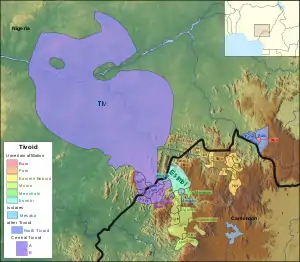| Tivoid | |
|---|---|
| Geographic distribution | Southeastern Nigeria, southwestern Cameroon |
| Linguistic classification | Niger–Congo? |
| Proto-language | Proto-Tivoid |
| Glottolog | tivo1239 |

| |
The Tivoid languages are a branch of the Southern Bantoid languages spoken in parts of Nigeria and Cameroon. The subfamily takes its name after Tiv, the most spoken language in the group.
The majority are threatened with extinction. The largest of these languages by far is the Tiv language for which the group is named; it had 2 million speakers in 1991. The second largest is the Bitare language; it had 110,000 speakers in 2000. Most apart from Tiv are extremely poorly known, and the next best, Esimbi, has not even been demonstrated to be Tivoid.
Languages
Following Blench (2010), Tivoid languages fall into three branches, though North Tivoid languages are almost unattested. The names in parentheses are dialects per Ethnologue, separate languages per Blench:
Esimbi is well attested, but there is not much reason to consider it Tivoid; it has just about as much in common with Grassfields languages.[1] The status of Buru within Tivoid is also uncertain.[1]
SIL Ethnologue lists three additional languages, Manta, Balo and Osatu, based on an old, provisional assignment of Blench; Blench (2010) states they are instead in the Southwest Grassfields (Western Momo) family.
The Momo languages, traditionally classified as Grassfields, may be closer to Tivoid, though that may be an effect of contact.[2]
Menchum, traditionally classified as Grassfields, may also be a Grassfields language or closer to Tivoid.
Names and locations (Nigeria)
Below is a list of Tivoid language names, populations, and locations (in Nigeria only) from Blench (2019).[3]
| Language | Cluster | Alternate spellings | Own name for language | Endonym(s) | Other names (location-based) | Other names for language | Exonym(s) | Speakers | Location(s) |
|---|---|---|---|---|---|---|---|---|---|
| Abon | Abong | Abõ | Abõ | Abon | Ba’ban | Only spoken in Abong town | Taraba State, Sardauna LGA, Abong town (east of Baissa) | ||
| Batu cluster | Batu | 25,000 (SIL) | Taraba State, Sardauna LGA, several villages east of Baissa, below the Mambila escarpment | ||||||
| Amanda–Afi cluster | Batu | Taraba State, Sardauna LGA, Batu Amanda and Batu Afi villages | |||||||
| Angwe | Batu | Taraba State, Sardauna LGA, Batu Angwe village | |||||||
| Kamino | Batu | Taraba State, Sardauna LGA, Batu Kamino village | |||||||
| Emane | Amana | No proof of permanent communities in Nigeria | Cross River State, Obudu LGA; and in Cameroon | ||||||
| Evant | Avande, Evand, Ovande | Balagete, Belegete | Cross River State, Obudu LGA and in Cameroon | ||||||
| Iceve cluster | Iceve | Banagere, Iyon, Utse, Utser, Utseu | 5,000 in Nigeria, 7,000 in Cameroon (1990 est.) | Cross River State, Obudu LGA and in adjacent Cameroon | |||||
| Ceve | Iceve | Icheve, Becheve, Bacheve, Bechere, | Iceve | Baceve | Ochebe, Ocheve (names of founding ancestor) | Cross River State, Obudu LGA and mainly in adjacent Cameroon | |||
| Maci | Iceve | Matchi | Maci | Kwaya, Olit, Oliti | Cross River State, Obudu LGA | ||||
| Iyive | Uive | Yiive | Ndir | Asumbo (Cover term used in Cameroon) | 2,000 | Benue State, Kwande LGA, near Turan; and in Cameroon (several villages in Manyu Département) | |||
| Otank | Utanga, Otanga | 2,000 (1953 Bohannan); 2,500 (SIL) | Cross River State, Obudu LGA; Benue State, Kwande LGA | ||||||
| Tiv | Tív, Tivi | Munshi (not recommended) | 800,000 (1952); 1,500,000 (1980 UBS) | Benue State, Makurdi, Gwer, Gboko Kwande, Vandeikya and Katsina Ala LGAs; Nasarawa State, Lafia LGA; Taraba State, Wukari, Takum, Bali LGA; and in Cameroon | |||||
| Ugarә | Binangeli, Messaka | 5000 (1994 est.) | Cassetta & Cassetta (1994): ‘Probably 75‒80% of Ugare speakers live on the Cameroon side of the border, in the Akwaya subdivision of Cameroon’s Southwest Province.’ | ||||||
| Bitare | Njwande, Yukutare | 3,700 in Cameroon (1987 SIL); 3,000 in Nigeria (1973 SIL) | Taraba State; Sardauna LGA, near Baissa; and in Cameroon | ||||||
| Ambo | A single village east of Baissa | Taraba State, Sardauna LGA |
See also
- Tivoid word lists (Wiktionary)
Notes
- 1 2 Blench, Roger (2010). "The Tivoid Languages" (PDF). p. 13.
- ↑ Blenh, Roger (2010). "Classification of Momo and West Momo" (PDF).
- ↑ Blench, Roger (2019). An Atlas of Nigerian Languages (4th ed.). Cambridge: Kay Williamson Educational Foundation.
References
- Blench, Roger. 2010. The Tivoid Languages
- Blench, Roger. 2016. The Tivoid Languages: overview and comparative word list.
![]() This article incorporates text available under the CC BY 3.0 license.
This article incorporates text available under the CC BY 3.0 license.